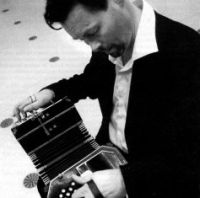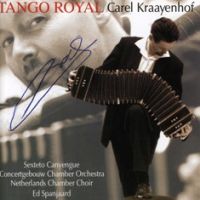A Tango Primer: One of the first "World Musics"
Mary Ellyn Hutton
Posted: Oct 2, 2009 - 5:44:41 PM in
news_2009

Carel Kraayenhof playing the bandoneon
(photo by Rob Becker)
|
Tango is powerful.
It can move even royals to tears.
It did just that in the hands (literally) of Dutch bandoneonist Carel Kraayenhof at the wedding of crown prince Willem-Alexander and Princess Maxima of the Netherlands in February, 2002.
The princess, who is from Argentina, birthplace of the tango, asked Craayenhof to play tango nueva master Astor Piazzolla's "Adios Nonino" at the wedding, said Kraayehnof, and it moved her and much of the audience to tears. Kraayenhof will perform Piazzolla's Concerto for Bandoneon, "Aconcagua," with the Cincinnati Symphony Orchestra led by guest conductor Kristjan Järvi at 8 p.m. Oct. 2 and 3 at Music Hall. It will be a CSO premiere.
Princess Maxima's emotional response to the music of her native country brought the Dutch artist to public attention and helped his 2002 CD "Tango Royal" go platinum ("Adios Nonino" is the last cut on the album, which also includes Piazzolla's tango-inflused Concerto).

cover design by Rob Becker
|
"Basically, all Argentinians carry this feeling," said Kraayenhof. "The people of Argentina are just like the American people. They have origins in Europe, like in Italy or Ireland. The Argentinian Society in Buenos Aires is much formed by Italian immigration, Germans, Spanish people -- from everywhere in Europe, from East Europe, also."
The tango, he explained, "was developed by these immigrants who came together in Buenos Aires. They had the great hope of making a fortune in Argentina. But it was much unlike the United States, where people went and could conquer land. When the people came to Buenos Aires, they discovered that already the whole country is divided by 300 Spanish families, the first colonists who settled in Argentina.
"They had these huge estancias, these ranches, a lot of land. So the immigrants who arrived in Argentina discovered that there was no land to conquer anymore. It was already divided and they ended up in industry in the big city, Buenos Aires. They remained poor. They had their housing in abandoned buildings of the army and were living like 100 people with one space."
As people do universally, they expressed their feelings in music.
"They made this new music, the tango, which always carried this melancholy feeling of the immigrant who is longer back in his native country. And they were mostly men. It was men who immigrated. They hoped to send money to their families to bring them over, but many couldn't. They didn't make any money."
Tango is one of the first examples of what we now called "world music," Kraayenhof explained.
"The tango was built up of many musics. You had, for example, all European folk music, like Spanish, Italian, French, German music. Mazurkas, waltzes, the tango andaluz from Spain, the canzioneta from Italy. Of course, they had all this classical music that they listed to from Europe, the whole instrumentarium, like the piano, violin, viola, cello, guitar, double bass and the bandoneon, which came from Europe."
The bandoneon, which is inextricably associated with the tango (Piazzolla himself was a bandoneonist), is named for Heinrich Band who created it in the early 19th-century in Germany. It is like a long accordion, but has only buttons, no keys. It is also related to the concertina and the harmonium. (Kraayenhof demonstrated its affecting sound -- and the complexity of performing it! -- during the interview.)
There was an important African influence on tango, too.
"The Spanish colonists brought slaves from Africa and they had a huge influence on the rhythm. There's a rhythm which they describe as 'the festive rhythm of the empty stomach.' And then you have the main rhythm from Argentina, which is really from the countryside, from the gauchos, the South American cowboys."
The gauchos had a rhythm called milonga, said Kraayenhof. "The milonga is like guitar-accompanied music sung by the gauchos, by passadores, which were troubadors.
"On horseback they went from village to village, and in a kind of duet form, they were telling each other stories about the last village there were in, what happened. And the other guy says, 'I'll tell you even more. 'In that village, this happened . . .'"
The milonga came to Buenos Aires because many gauchos lost their jobs, Kraayenhof said.
"The ranches were bigger and bigger and many gauchos had to look for work in the big city. In the circle around Buenos Aires, you had all these slaughter houses. All these cows were driven to the big city, and the gauchos ended up in the city. Milonga, their music, mixed with the habanera from Cuba. The slaves came by the colonists first to Cuba, which was the commercial center, and then they sent these slaves to Buenos Aires and they brought the habanera. The milonga and the habanera mixed together.
"There were dance evenings in Buenos Aires where this music was the party music, the disco of that time."
What became the tango varies in its rhythm from this earlier hybrid, he said. "It was much influenced by the Europeans."
The European component of tango is, in fact, "much bigger," he said.
Hear Carel Kraayenhof perform the Concerto for Bandoneon, "Aconcagua," by Astor Piazzolla at 8 p.m. Oct. 2 and 3 at Music Hall in Cincinnati. Guest conductor Kristjan Jarvi will conduct. Also on the program -- an all Latin American one -- are Four Dances from Alberto Ginastera's "Estancias" and "Le Noche de los Mayas" ("The Night of the Mayas") by Mexican composer Silvestre Revueltas. Admission is $10-$95 at the CSO box office in Music Hall, call (513) 381-3300, or order online at www.cincinnatisymphony.org.


